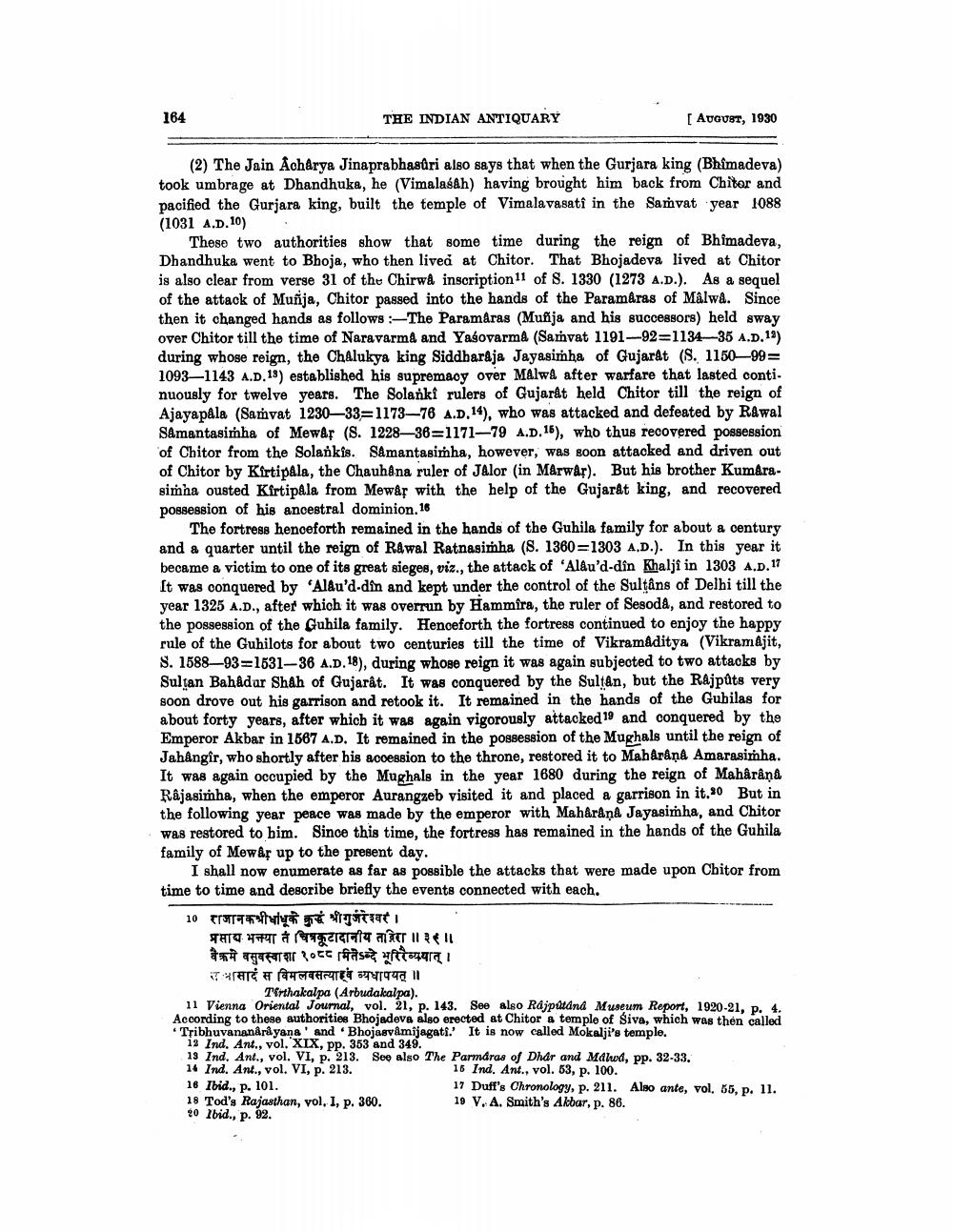________________
164
THE INDIAN ANTIQUARY
[ August, 1930
(2) The Jain Acharya Jinaprabhasűri also says that when the Gurjara king (Bhimadeva) took umbrage at Dhandhuka, he (Vimalasah) having brought him back from Chitor and pacified the Gurjara king, built the temple of Vimala vasati in the Samvat year 1088 (1031 A.D.10)
These two authorities show that some time during the reign of Bhimadeva, Dhandhuka went to Bhoja, who then liveå at Chitor. That Bhojadeva lived at Chitor is also clear from verse 31 of the Chirwa inscription 11 of S. 1330 (1273 A.D.). As a sequel of the attack of Muñija, Chitor passed into the hands of the Paraméras of Malwa. Since then it changed hands as follows The Paramâras (Muñja and his successors) held sway over Chitor till the time of Naravarma and Yasovarma (Samvat 1191-92=1134-35 A.D. 19) during whose reign, the Chalukya king Siddhardja Jayasimha of Gujarat (s. 1150—99= 1093–1143 A.D. 18) established his supremacy over Malwa after warfare that lasted conti. nuously for twelve years. The Solanki rulers of Gujarat held Chitor till the reign of Ajayapala (Samvat 123033=1173–76 A.D. 14), who was attacked and defeated by Rawal Samantasimha of Mewar (S. 1228-36=1171–79 A.D. 16), who thus recovered possession of Chitor from the Solankis. Samantasimha, however, was soon attacked and driven out of Chitor by Kirtipala, the Chauhôna ruler of JAlor (in Marwar). But his brother Kumarasimha ousted Kirtipala from Mewar with the help of the Gujarat king, and recovered possession of his ancestral dominion. 16
The fortress henceforth remained in the hands of the Guhila family for about a century and a quarter until the reign of Rawal Ratnasimha (S. 1360=1303 A.D.). In this year it became a victim to one of its great sieges, viz., the attack of 'Alau'd-din Khalji in 1303 A.D. 17 It was conquered by 'Alau'd-din and kept under the control of the Sultâns of Delhi till the year 1325 A.D., after which it was overrun by Hammira, the ruler of Sesoda, and restored to the possession of the Guhila family. Henceforth the fortress continued to enjoy the happy rule of the Guhilots for about two centuries till the time of Vikramaditya (Vikramajit, 8. 1688–93=1631-36 A.D. 18), during whose reign it was again subjected to two attacks by Sultan Bahadar Shah of Gujarât. It was conquered by the Sultan, but the Rajputs very soon drove out his garrison and retook it. It remained in the hands of the Gubilas for about forty years, after which it was again vigorously attacked 19 and conquered by the Emperor Akbar in 1587 A.D. It remained in the possession of the Mughals until the reign of Jahangir, who shortly after his accession to the throne, restored it to Maharana Amarasimha. It was again occupied by the Mughals in the year 1680 during the reign of Mahârâna Râjasimha, when the emperor Aurangzeb visited it and placed a garrison in it.30 But in the following year peace was made by the emperor with Mahârâna Jayasimha, and Chitor was restored to him. Since this time, the fortress has remained in the hands of the Guhila family of Mew&p up to the present day.
I shall now enumerate as far as possible the attacks that were made upon Chitor from time to time and describe briefly the events connected with each. 10 praraata ge TITI
प्रसाय भन्या ते चित्रकूटादानीय तद्विरा ॥३॥ वैक्रमे वसुबस्वाशा १०८८ मितेऽन्दे भरिरैव्ययात् । रासादं स विमलवसत्यावं व्यधापयत् ॥
Tirthakalpa (Arbudakalpa). 11 Vienna Oriental Journal, vol. 21, p. 143. See also Rajputand Museum Report, 1920-21, p. 4. According to these authorities Bhojadeve also erected at Chitor a templo of Siva, which was then called TribhuvananAriyana' and Bhojasvåmijagati.' It is now called Mokalji's temple. 12 Ind. Ant., vol. XIX, pp. 353 and 349. 13 Ind. Ant., vol. VI, p. 213. See also The Parmdrae of Dhdr and Malwd, pp. 32-33. 14 Ind. Ant., vol. VI, p. 213.
16 Ind. Ant., vol. 63, p. 100. 16 Ibid., p. 101.
17 Duff's Chronology, p. 211. Also ante, vol. 65, p. 11. 18 Tod's Rajasthan, vol. I, p. 360.
19 V. A. Smith's Akbar, p. 86. 20 Ibid., p. 92.




